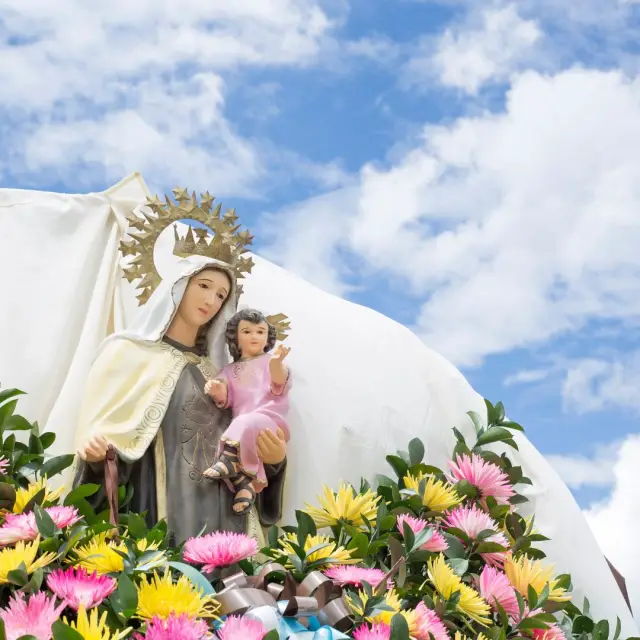The Virgen del Carmen festivities are one of the most important religious and cultural events in Colombia. Celebrated every July 16, these festivities honor the Virgen del Carmen, patron saint of drivers, transporters and various guilds, such as sailors and military personnel.
Origin and History of the Devotion
The devotion to Our Lady of Mount Carmel has its roots in Mount Carmel, located in Israel, where a group of hermits dedicated themselves to the prayer and veneration of the Virgin Mary under this title. This tradition spread to Europe during the 13th century with the creation of the Carmelite Order and, later, it arrived in America with the Spanish colonizers.
In Colombia, devotion to the Virgin of Carmen began to take root during the colonial era. Over time, the Virgin became a symbol of protection, especially for those who worked in activities related to land, river and sea transport. In 1946, Pope Pius XII proclaimed the Virgin of Carmen as the official patron saint of drivers in Colombia, further strengthening her place in the country's religion and popular culture.
Celebrations Across the Country
Although the festival of the Virgin of Carmen is celebrated throughout the country, each region has particular traditions that reflect its cultural identity. Below are some of the most notable celebrations:
Bogotá and the Cundiboyacense Plateau
In the capital, the festival includes solemn masses, processions and blessings of vehicles. Parishes dedicated to the Virgin of Carmen are usually decorated with flowers and lights, attracting hundreds of faithful. In nearby municipalities such as Chía and Zipaquirá, the tradition includes parades of old cars and cultural activities that combine faith with local identity.
Colombian Caribbean
In cities such as Cartagena, Barranquilla and Santa Marta, the festivities have a special character due to the region's strong connection with the sea. Fishermen and sailors participate in aquatic processions, carrying the image of the Virgin in decorated boats. These celebrations include music, typical dances and traditional dishes, such as coconut rice and fried fish.
Cauca Valley and Coffee Belt
In cities such as Cali, Pereira and Manizales, the Virgin of Carmen is venerated with caravans of transporters who decorate their vehicles with flags, balloons and flowers. The blessings of cars and motorcycles are a central act, symbolizing divine protection for those who work on the roads.
Andean Region and Eastern Plains
In regions such as Antioquia, Boyacá and the Eastern Plains, celebrations combine religious devotion with cultural events. In Medellín, for example, there are open-air masses and popular fairs. In Villavicencio, activities include joropos, horseback riding and coleo competitions.
Cultural Components of the Celebration
The celebrations of the Virgen del Carmen are not only religious events, but also cultural ones. Below are some of the most representative elements:
Processions
Processions are the central theme of the celebration. These are usually carried out on foot, in vehicles or even in boats, depending on the region. During the procession, the faithful sing hymns, pray the rosary and accompany the image of the Virgin with flowers and candles.
Music and Dance
Music plays a fundamental role in the festivities. In the Caribbean, bagpipes and drums accompany the processions, while in the interior of the country religious songs and popular bands can be heard. In addition, in some regions there are performances of typical dances, such as mapalé and bambuco.
Gastronomy
Food is also an essential part of the celebrations. The faithful often share traditional dishes during fairs and community events. Among the most notable are arepa de choclo, sancocho and tropical fruit sweets.
Art and Decoration
The image of the Virgin of Carmen is usually decorated with care. In churches, streets and vehicles, flowers, lights and pennants are used to reflect the joy and devotion of the faithful. In addition, it is common to see improvised altars in homes and businesses, where families pay homage to the Virgin.
Social and Economic Impact
The celebrations of Our Lady of Mount Carmel have a significant impact on local communities. From a social point of view, these celebrations foster unity and solidarity among the faithful. Families, friends and neighbours gather to participate in the activities, strengthening community ties.
Economically, the festivities generate income for various sectors. Local merchants take advantage of the increase in visitors to offer products and services related to the celebration, such as food, crafts and decorations. In addition, the events attract national and international tourists, promoting the development of religious tourism.
Despite their importance, the Virgen del Carmen festivities face some challenges. These include the need to preserve traditions in the face of globalization and the risk that religious aspects will be overshadowed by commercial interests. In addition, in some regions, the celebrations have been marked by security and logistical problems due to the large number of attendees.
To ensure the continuity of these festivities, it is essential to promote cultural and religious education, as well as to implement measures that ensure sustainability and order during the events. This includes collaboration between local authorities, communities and churches.
The celebrations of the Virgin of Carmen are a living expression of Colombian faith and culture. Beyond their religious character, these celebrations represent a legacy that unites communities and highlights the country's diversity. Every July 16, Colombians renew their devotion and celebrate the Virgin of Carmen with joy, reaffirming their identity and traditions.
Over time, these holidays continue to evolve, adapting to social and cultural changes, but always retaining their essence. They are a reminder of the importance of preserving our traditions and of the ability of faith to inspire and unite people around a common purpose.
